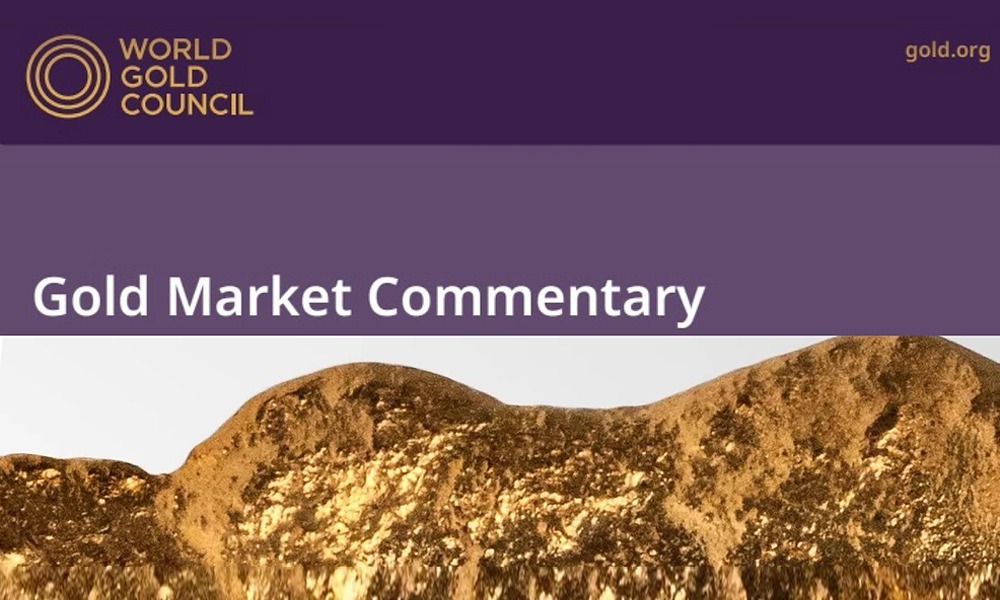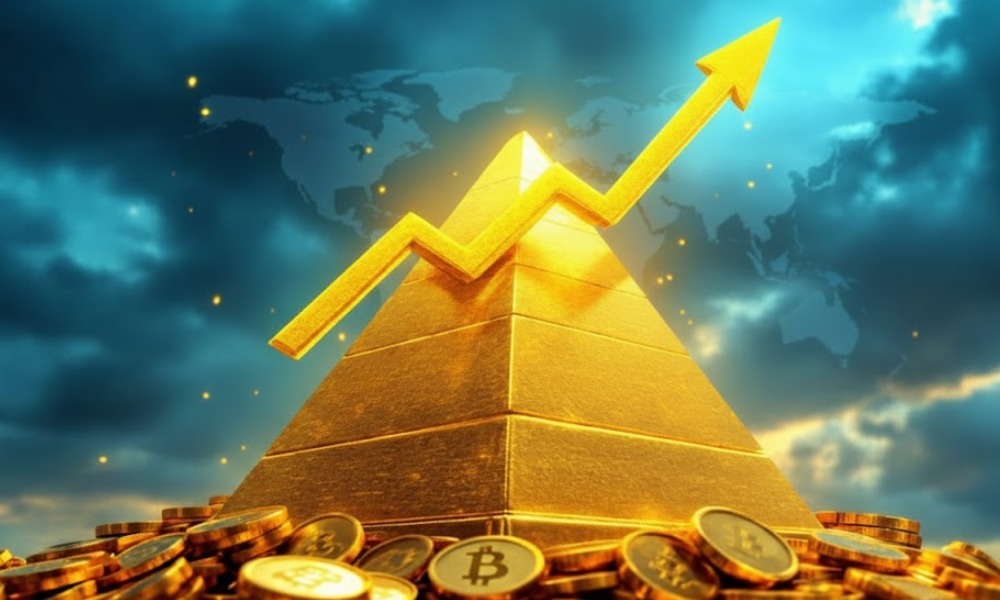International News
WGC Gold Market Commentary: Strong euro and tariff fears drive gold

Another month, another set of new highs. Gold finished March 2025 at US$3,115/oz, a gain of 9.9% m/m.Even a materially weaker US dollar, primarily via euro strength, couldn’t prevent a stellar performance and new highs across all other major currencies .
According to our Gold Return Attribution Model (GRAM), euro strength and thus US dollar weakness was once again a key driver of gold’s performance, alongside an increase in geopolitical risk capturing tariff fears. Gold ETF buying continued apace in March with all regions contributing. US funds led the charge with US$6bn (67t) of net inflows followed by Europe then Asia with approximately US$1bn each. While ETF flows were positive, COMEX futures declined marginally by US$400mn (5t) likely on profit taking.
March review
A stronger euro, tariff fears and ETF buying edged gold to new highs once again in March.
Looking forward
Fiscal and monetary support may be receding, and the timing isn’t great for risk assets given current turmoil. Fundamentals remain solid for gold.
• Liquidity matters, and has arguably been bolstering both financial assets and the economy in the US for much of the post-COVID period
• In 2022, however, US financial conditions tightened forcefully as liquidity was removed from markets. This perfect storm caused a very rare annual joint decline in bonds and equities. Gold held up but also experienced some bumps along the way
• We are now at a similar impasse in liquidity conditions, but with crucial differences that bode well fundamentally for gold
• The one hurdle is the hitherto strong run-up in gold prices. Comparisons to the 2011 and 2020 peaks are likely to be made, but in our view, the environment remains supportive of further gains.
While by no means the sole contributors to their solid performance, the US economy and financial markets benefited from monetary and fiscal support since the COVID pandemic.
activity). Gold also succumbed, falling 20% over two quarters
in 2022, before a recovery to end the year flat. Proving direct causality is difficult, yet it does suggest markets and the economy had grown accustomed to artificial support.
At a crossroads
While much of the conversation over the past week has centred around tariffs, liquidity risk remains an important undercurrent. And we believe we may now be approaching a similar impasse to what markets experienced in 2022.
Quantitative tightening is slowing but there has been no mention of a resumption of quantitative easing. Indeed, the appetite might not be there given the high levels of debt and sticky inflation. In addition, constraints on government spending via the Department of Government Efficiency (DOGE) are stifling fiscal support. And the Fed’s Overnight Reverse Repo facility (ON RRP) is low, which provides less wiggle room for the Fed to manage liquidity issues. This appears to be showing up in stats like order-book liquidity for equity futures and – as flagged in the Fed’s financial stability report in November– on-the-run bond liquidity. It may also be contributing to the year-to-date equity rout.
And the labour market is flirting with contraction as hours worked are in steep decline. Logically they lead an employment slowdown as companies reduce hours for staff before layoffs; statistically this also appears to be the case. But layoffs are also now on the rise and are likely to feed into payroll numbers in due course (Chart 5). To add to this, uncertainty surrounding tariffs has supercharged concerns about the resiliency of labour markets in the short and medium term.
While inflation was rising more in 2022, it was driven by growth. This time around inflation is sticky while growth is faltering, resulting in a stagflationary environment. In this context, rates are unlikely to be going up from here and further weakening of the dollar is likely on waning US exceptionalism
Central banks have been strong contributors to gold’s performance over the past three years and show few signs of letting up, adding fundamental support to prices
US gold ETF investors had built up sizeable holdings in 2020 prior to the 2022 wobbles. But they have been sidelined until recently, suggesting capacity to keep adding.
Fundamentals remain in place…
The current run-up in price has taken many by surprise. Paraphrasing an old adage, shouldn’t high prices for a commodity cure high prices? Gold is not a commodity in the traditional sense and primary production’s response may have only limited impact on price. The willingness to hold and reluctance to sell – given current extreme policy uncertainty – could generate real momentum. By historical standards, the current rally isn’t particularly large or long. And comparing the current rally to the recent 2011 and 2020 peaks highlights that, relatively speaking, fundamentals look more solid (Table 2):
• US gold ETFs are a considerably smaller share of all US ETF assets than during 2011 as ETF buyers have been on the sidelines for the best part of four years they are not overbought
• Real yields are higher and above their long-run average, suggesting more downside than upside risk for yields – and vice versa for gold prices
• Forward equity price-to-earnings remains high, and that provides capacity for further downside to equities should an economic slowdown and earnings downgrades worsen, especially in the current geoeconomic conditions, a boon for gold’s safe-haven appeal
• Credit spreads are considerably tighter than during the two previous peaks. Again, widening risks trump contraction risk, and are also gold supportive.
• The dollar remains elevated relative to prior periods even if it has weakened since the start of the year. With the Trump administration favouring a weaker dollar and the uncertain effect of tariffs, this could serve as an additional tailwind for gold.
…But not without risks
But we also caution that there are risks for the gold price after a rally such as this in such a short space of time.
Treasury managers at central banks could prudently slow their pace of buying given the price rally, as we saw with some central banks last year. While consumer demand adapts to higher prices eventually, the speed of price moves is like to dampen net buying in the near term. A liquidity crunch could negatively affect gold as the most liquid assets are sold to meet margin calls.
Additionally, geopolitical and policy nervousness is quite elevated, particularly given significant uncertainty about tariffs and its effect on market volatility, which is likely adding a meaningful premium to gold prices. Any resolution could bring that premium out as we have seen in previous historical periods.
In sum…
The extent and speed of gold’s rally has drawn out comparisons to previous peaks. While there are headwinds that the gold market will naturally face in this environment, our analysis also suggest that current macroeconomic conditions are quite different to prior periods when the gold market reached previous highs.

International News
Gold continues upward march;Bank of America forecasts $5,000/oz for 2026

Gold prices in India saw a modest rise on Wednesday today Oct 15, mirroring an uptick in international markets as renewed US-China trade tensions and expectations of further US interest rate cuts bolstered demand for safe-haven assets.24k gold traded at Rs.1,28,360/10gm after gaining ₹10 in early trade, while silver prices increased by Rs.100 to Rs.1,89,100 per kilogram.
Gold prices surged to a record high of $4,179.48 per ounce on October 14, 2025. Investors flocked to safe-haven metals amid trade tensions and Fed rate-cut expectations. U.S. December gold futures jumped 57% year-to-date. Bank of America raised its 2026 gold forecast to $5,000 per ounce, warning of possible near-term corrections.
Gold prices soared to an unprecedented $4,179.48 per ounce on October 14, 2025, marking a historic milestone for the yellow metal. The rally comes as investors worldwide seek safety in hard assets amid a turbulent global economic backdrop marked by escalating trade tensions, slowing growth, and expectations of further interest rate cuts by the U.S. Federal Reserve.
The sharp surge in bullion prices has been driven by a combination of macroeconomic uncertainty and aggressive monetary easing. As inflation pressures remain sticky and central banks pivot toward dovish policies, gold has reasserted its role as a hedge against both currency debasement and market volatility.
In futures trading, U.S. December gold contracts have skyrocketed nearly 57% so far this year, underscoring the strength of investor demand across both institutional and retail segments. Analysts note that central bank buying—particularly from emerging markets—has added further momentum to the rally, with several countries diversifying reserves away from the U.S. dollar.
Reflecting this bullish sentiment, Bank of America has raised its 2026 gold price forecast to $5,000 per ounce, citing continued monetary easing, geopolitical instability, and robust central bank accumulation. However, the bank also cautioned that short-term corrections are likely, given the rapid pace of the recent run-up and potential bouts of profit-taking.
Overall, gold’s meteoric rise underscores a broader shift toward safe-haven assets, as investors navigate a world increasingly defined by economic fragmentation, shifting interest rate cycles, and persistent geopolitical risks.
-

 National News9 hours ago
National News9 hours agoSenco Gold & Diamonds launches affordable 9k gold jewellery starting under ₹7,000, a Game-changer amid fluctuating gold prices this Dhanteras
-

 BrandBuzz9 hours ago
BrandBuzz9 hours agoMavitrra Launches “The Amara Collection” – A Timeless Celebration of Bridal Grandeur and Festive Luxury
-

 Education10 hours ago
Education10 hours agoIndian jewellery trade and industry expectations & trends
-

 GlamBuzz13 hours ago
GlamBuzz13 hours agoDazzling Divas and Star Power: Inside Manish Malhotra’s Grand Diwali Celebration




